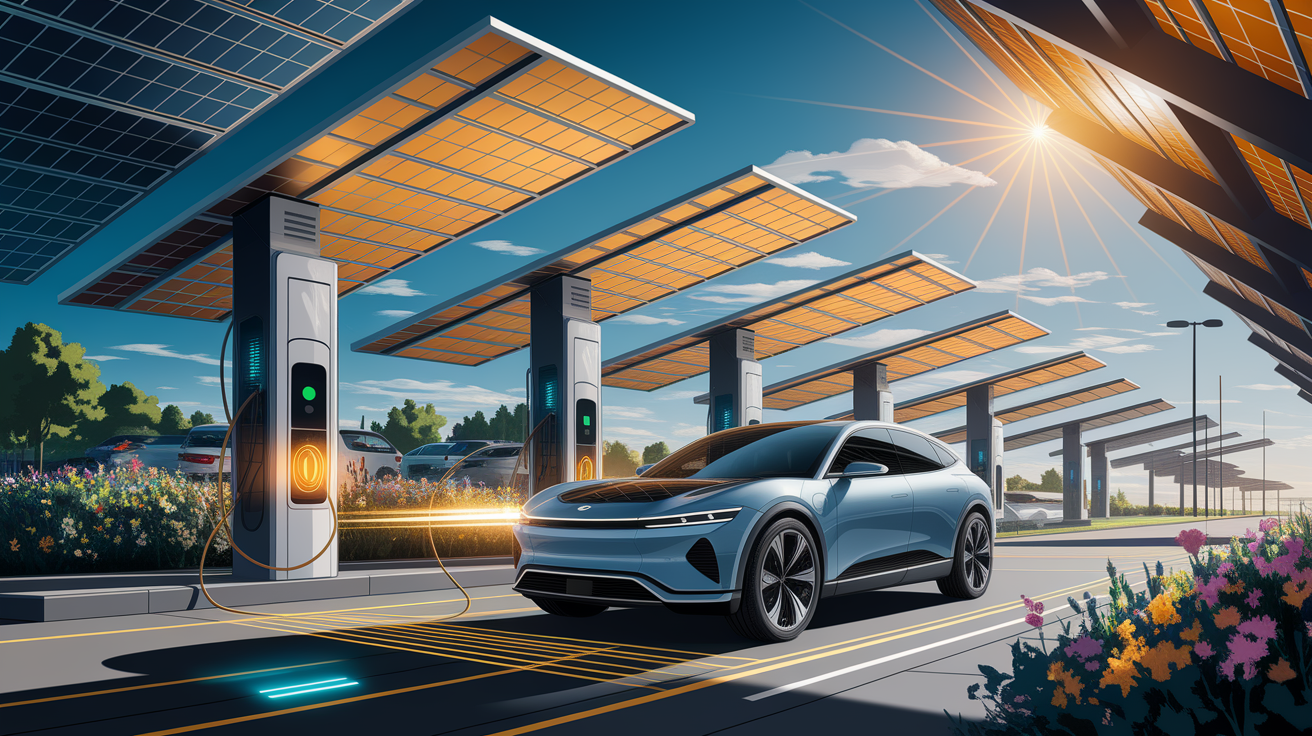Powering the Future: Depot Solar EV Fleet Charging
Introduction – Sun-Powered Charge-Up
As commercial fleets transition toward sustainable transportation, depot solar EV fleet charging is emerging as a cornerstone of modern fleet electrification. By integrating solar charging stations and depot charging infrastructure, fleet managers can reduce reliance on the grid, lower operational costs, and cut carbon emissions. This approach leverages photovoltaic systems mounted on solar canopies or rooftops to power electric vehicle fleets directly at the charging depot, combining energy independence with operational efficiency.

Depot charging – the practice of recharging electric vehicles at a central location – is ideal for fleet vehicles such as delivery vans, transit buses, and heavy trucks that return to base between shifts. Adding renewable energy technologies to these depots represents a logical evolution in fleet electrification strategy, aligning with corporate sustainability goals and the growth of the EV charging network.
Key Benefits of Depot Solar EV Fleet Charging
- Reduced Operating Costs: Onsite solar generation offsets grid electricity use, lowering utility bills and mitigating peak demand charges.
- Energy Resilience: Incorporating battery storage and smart energy management systems ensures charging availability during grid disruptions.
- Sustainability Gains: Solar-powered depot charging directly reduces greenhouse gas emissions and supports corporate ESG targets.
- Optimized Fleet Management: Centralized charging increases scheduling control, enabling off-peak charging to improve total cost of ownership (TCO).
- Scalability: Depots designed for renewable fleet charging can expand to accommodate growing vehicle counts and future technologies.
Essential Components
A successful solar powered electric vehicle fleet charging depot typically includes:

- Solar Panels / Photovoltaic Systems: Solar canopies or rooftop arrays that convert sunlight into electricity for direct vehicle charging.
- Chargers: Level 2 units for overnight charging or DC Fast Chargers (DCFC) for rapid turnaround, chosen based on route lengths and fleet duty cycles (AFDC guidance).
- Battery Storage: Energy storage systems for load balancing, peak shaving, and backup supply.
- Energy Management System: Smart microgrid controllers to coordinate solar, grid, and storage resources.
- Depot Charging Infrastructure: Electrical capacity upgrades, cabling, and compatible connectors to ensure safe, efficient operation.
- Charging Station Design: Site layout optimized for space, vehicle flow, and safety.
Implementation Steps
- Assess Fleet Needs: Determine vehicle types, route lengths, charging windows, and energy consumption profiles.
- Plan Infrastructure: Match chargers to vehicle requirements, evaluate electrical service capacity, and define space constraints (PowerFlex infrastructure planning).
- Integrate Solar: Size photovoltaic systems to meet a percentage of total fleet energy demand, factoring in local irradiance and roof/canopy area.
- Incorporate Battery Storage: Determine storage capacity needs for smoothing solar variability and supporting resiliency.
- Install Energy Management and Scheduling Software: Use platforms for charger control, load balancing, and route-based scheduling (Ampcontrol insights).
- Coordinate with Utilities and Authorities: Secure interconnection agreements, permits, and inspections to comply with local regulations.
Financing and Incentives
Investing in commercial fleet solar EV charging infrastructure can be offset through a combination of federal tax credits, state renewable energy grants, and utility incentives for demand management. Programs like the U.S. Investment Tax Credit (ITC) for solar installations and fleet charging rebates from utilities can significantly lower capital expenses. In addition, leasing models for solar canopy charging systems and battery storage can spread costs over time, aligning expenses with operational savings.
ROI Considerations
Return on investment for depot solar installations depends on energy price offsets, demand charge reductions, and avoided fuel costs. Well-planned projects can achieve payback in under 10 years, particularly for high-mileage commercial vehicles.
Overcoming Common Challenges
- Space Constraints: Creative use of vertical and canopy-mounted solar arrays can yield high generation in limited footprints.
- Upfront Costs: Financing tools and incentive stacking help address capital barriers.
- Grid Integration: Coordinating with utilities minimizes interconnection delays and ensures capacity for high-power chargers.
- Technology Compatibility: Ensuring charger types match fleet vehicles and future-proofing for evolving standards.
- Regulatory Compliance: Adhering to fire codes, permitting requirements, and environmental regulations.
Real-World Examples
Across the U.S., municipalities and logistics companies are piloting depot renewable energy projects. In California, a transit agency deployed solar canopy electric fleet charging with onsite battery storage, enabling buses to maintain service during grid outages (Automotive Fleet case studies). A global delivery firm integrated commercial solar EV depot charging into its fleet management systems, using smart scheduling software to synchronize vehicle charging with midday solar peaks, reducing both costs and emissions.
These projects demonstrate how solar EV integration at charging depots can transform traditional fleet operations into sustainable fleet operations, setting a blueprint for widespread adoption.
Conclusion – Charging Ahead with the Sun
Depot-based solar EV fleet charging merges the proven convenience of central charging locations with the innovation of renewable energy. By combining solar panels, battery storage, and intelligent energy management systems, commercial fleets can achieve reliable, clean, and cost-effective operations. This integration addresses critical goals in fleet sustainability, reduces dependence on fossil fuels, and enhances resilience against energy price volatility and grid instability.
As fleet electrification accelerates and charger technology advances, investing in solar powered electric vehicle fleet charging depots is more than a sustainability measure—it’s a strategic, future-ready decision for fleet operators navigating the changing landscape of transportation energy.







